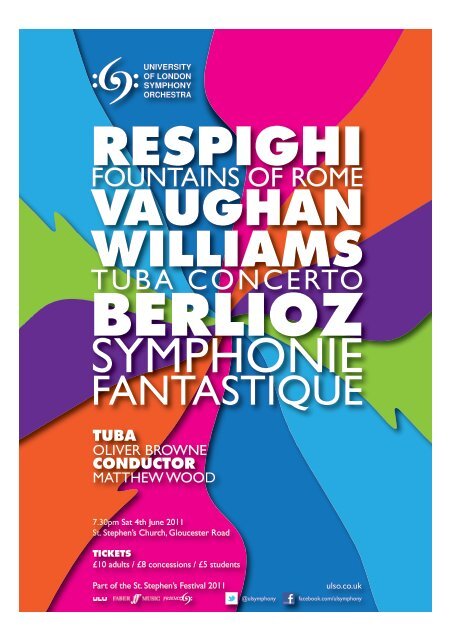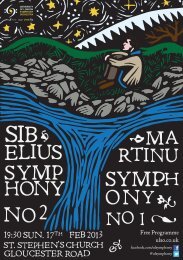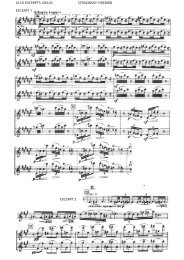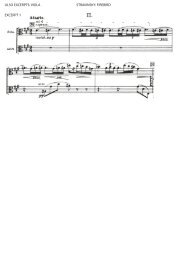Programme - University of London Symphony Orchestra
Programme - University of London Symphony Orchestra
Programme - University of London Symphony Orchestra
You also want an ePaper? Increase the reach of your titles
YUMPU automatically turns print PDFs into web optimized ePapers that Google loves.
RESPIGHI<br />
FOUNTAINS OF ROME<br />
VAUGHAN<br />
WILLIAMS<br />
TUBA CONCERTO<br />
BERLIOZ<br />
SYMPHONIE<br />
FANTASTIQUE<br />
TUBA<br />
OLIVER BROWNE<br />
CONDUCTOR<br />
MATTHEW WOOD<br />
7.30pm Sat 4th June 2011<br />
St. Stephen’s Church, Gloucester Road<br />
TICKETS<br />
£10 adults / £8 concessions / £5 students<br />
Part <strong>of</strong> the St. Stephen’s Festival 2011<br />
@ulsymphony<br />
ulso.co.uk<br />
facebook.com/ulsymphony
<strong>Programme</strong><br />
RESPIGHI<br />
Fountains <strong>of</strong> Rome<br />
VAUGHAN WILLIAMS<br />
Tuba Concerto<br />
interval<br />
BERLIOZ<br />
Symphonie Fantastique<br />
PLEASE ENSURE THAT YOUR MOBILE PHONE IS<br />
SWITCHED OFF FOR THE DURATION OF THE PER-<br />
FORMANCE.
2 UNIVERSITY OF LONDON SYMPHONY ORCHESTRA<br />
FOREWORD<br />
Dear guests,<br />
Good evening and welcome to ulso’s Summer Concert. Tonight’s<br />
performance marks our fifth concert <strong>of</strong> the 2010–11 season<br />
and we are very pleased to be back at St. Stephen’s and to be<br />
involved in their Festival <strong>of</strong> Faith and Music. As well as being<br />
part <strong>of</strong> our biggest season to date, this concert is also the first<br />
outing <strong>of</strong> the new committee and the first time the orchestra has<br />
collaborated with a guest conductor, Matthew Wood.<br />
It has been extremely enjoyable to work with Matthew on this<br />
project. With a shorter than usual rehearsal period, Matthew<br />
has worked intensively with the orchestra while maintaining a<br />
relaxed atmosphere, which is, <strong>of</strong> course, important when taking<br />
on a new partnership. Our tuba soloist tonight, performing<br />
Vaughan Williams’ Tuba Concerto, is Oliver Browne, a former<br />
member <strong>of</strong> ulso. It is a great pleasure for the orchestra to play<br />
with him and we wish him all the best in his future endeavours.
I’d like to thank both Matthew and Oliver for all <strong>of</strong> their work<br />
this term—it is truly much appreciated.<br />
The orchestra’s next project will be a tour to Taormina in Sicily<br />
in July, where we will be performing at the remarkable Teatro<br />
Antico. The programme we will be working on will include Gershwin’s<br />
Piano Concerto in F, Rachmaninov’s <strong>Symphony</strong> No. 2<br />
and Verdi’s Requiem. I’m also pleased to announce that we will<br />
be performing a selection from our tour repertoire at a concert<br />
in aid <strong>of</strong> Cancer Research UK at St Luke’s, Chelsea, a few days<br />
before we depart for Sicily. Details can be found on our website<br />
or by asking members <strong>of</strong> the orchestra.<br />
Now that we are at the <strong>of</strong>ficial end <strong>of</strong> ulso’s 2010–11 season, I’d<br />
like to thank the orchestra’s Friends and our sponsor, Faber Music<br />
Ltd. Their support this year has been vital to the work <strong>of</strong> the<br />
orchestra and without it we would not be able to perform such<br />
fantastic repertoire or in such atmospheric venues as we have.<br />
I’d also like to take this opportunity to express my gratitude<br />
to all the members <strong>of</strong> the new committee. Upon being elected,<br />
each new member responded to their duties immediately and<br />
with great commitment. I have been invariably impressed with<br />
their helpfulness and energy and feel safely assured that next<br />
year will be as successful as it will be enjoyable.<br />
Finally, I want to thank you all for coming along tonight. I hope<br />
you enjoy the performance and look forward to seeing you at<br />
future concerts.<br />
Mercedes Malcomson<br />
ulso Chair<br />
FOREWORD<br />
3
4 UNIVERSITY OF LONDON SYMPHONY ORCHESTRA<br />
SOLOIST<br />
Oliver Browne<br />
Oliver began playing the tuba whilst still at school and was a<br />
member <strong>of</strong> the National Youth <strong>Orchestra</strong> <strong>of</strong> Wales, National<br />
Youth Wind <strong>Orchestra</strong> <strong>of</strong> Wales, National Youth Wind <strong>Orchestra</strong><br />
<strong>of</strong> Great Britain and the National Youth Brass Band <strong>of</strong><br />
Wales. Oliver also won many solo prizes including the bayv/<br />
rwcmd “Brass Champion <strong>of</strong> Tomorrow”, the National Eisteddfod<br />
<strong>of</strong> Wales and was awarded most outstanding wind player at<br />
the Swansea Music Festival. Oliver was runner up in the Young<br />
Musician <strong>of</strong> Dyfed in 2004, which led to a solo recital at the<br />
prestigious St David’s Cathedral Festival.<br />
In 2005 Oliver passed his atcl recital diploma with distinction<br />
and during this time, the American composer Paul Basler com-
6 UNIVERSITY OF LONDON SYMPHONY ORCHESTRA<br />
SOLOIST<br />
posed a piece for tuba and piano entitled “Serenade for Tuba<br />
and Piano” and dedicated it to Oliver.<br />
In September 2005 Oliver began studies at the Royal Northern<br />
College <strong>of</strong> Music. Whilst at the college Oliver was a member<br />
<strong>of</strong> the Fairey Band and also deputised with various brass bands<br />
including the ybs and Fodens Bands.<br />
In 2006 Oliver transferred to the Royal Welsh College <strong>of</strong> Music<br />
and Drama to study with Nigel Seaman. At the rwcmd, Oliver<br />
played in every major college ensemble and was a featured soloist<br />
with the college brass band. Oliver was also a member <strong>of</strong><br />
the Cory Band and in 2008 was the band’s featured soloist at<br />
the rncm Festival <strong>of</strong> Brass. Whilst at the rwcmd, Oliver was<br />
awarded the Leonard and Marian Jones Distinguished Music<br />
Scholarship Prize, the Linda Mowatt Brass Prize and the<br />
Ernest and Doris Haigh Memorial Award. Oliver also played<br />
in master classes with many pr<strong>of</strong>essional musicians including,<br />
James Anderson, Yasuhito Sugiyama, Fine Arts Brass Ensemble,<br />
Onyx Brass Ensemble and David Gordon Shute.<br />
Outside <strong>of</strong> college, Oliver is a busy freelance tuba player and has<br />
worked with the bbc National <strong>Orchestra</strong> <strong>of</strong> Wales, Welsh National<br />
Opera, Southbank Sinfoina, Video Games Live and was<br />
recently on trial with the Royal Scottish National <strong>Orchestra</strong>.<br />
Oliver is currently a postgraduate student at the Royal College<br />
<strong>of</strong> Music in <strong>London</strong>, studying with Lee Tsarmaklis and Owen<br />
Slade. n
CONDUCTOR<br />
Matthew Wood<br />
Australian-born conductor Matthew Wood now resides in the<br />
uk where he regularly works with some <strong>of</strong> the finest orchestras<br />
in the country and throughout Europe, South America and<br />
Australia.<br />
From 2007–2010 Matthew held the position <strong>of</strong> Associate Conductor<br />
with the Bournemouth <strong>Symphony</strong> <strong>Orchestra</strong> and has<br />
conducted other leading orchestras in the uk including the Philharmonia<br />
and the Royal Liverpool Philharmonic <strong>Orchestra</strong>.<br />
He is a regular guest conductor <strong>of</strong> the rte National Sympho-<br />
7
8 UNIVERSITY OF LONDON SYMPHONY ORCHESTRA<br />
CONDUCTOR<br />
ny <strong>Orchestra</strong> <strong>of</strong> Ireland, and has recently made his debut with<br />
the Orquesta Sinfonica Nacional de Chile. In Australia he has<br />
conducted numerous orchestras and ensembles including recent<br />
performances with the Queensland <strong>Symphony</strong> <strong>Orchestra</strong> and the<br />
Tasmanian <strong>Symphony</strong> <strong>Orchestra</strong>s. Upcoming engagements include<br />
work with the Royal Ballet Covent Garden, the Orquesta<br />
Clasica Santa Cecilia Madrid, the Melbourne <strong>Symphony</strong> <strong>Orchestra</strong><br />
and the contemporary opera company Tête à Tête.<br />
He is also in demand as a conducting teacher and is a regular guest<br />
lecturer and conductor at the Royal Northern College <strong>of</strong> Music<br />
where Matthew held the coveted position <strong>of</strong> Conducting Fellow<br />
from 2005–2007. During this time he was selected to conduct the<br />
<strong>London</strong> <strong>Symphony</strong> <strong>Orchestra</strong>, as part <strong>of</strong> their conductor discovery<br />
series, and received tuition from conductors Sir Mark Elder<br />
and Sir Colin Davis.<br />
Matthew completed his undergraduate music studies, graduating<br />
with first class honours at the <strong>University</strong> <strong>of</strong> New South Wales,<br />
majoring in composition. He then undertook postgraduate conducting<br />
studies at the Sydney Conservatorium where he received<br />
numerous scholarships before concentrating his studies under renowned<br />
conductor pedagogue Jorma Panula. n
10 UNIVERSITY OF LONDON SYMPHONY ORCHESTRA<br />
On Stage this Evening<br />
VIOLIN I<br />
Mervyn Chong Leader<br />
Olivia Jarvis Co-Leader<br />
Yean Chooi<br />
Naomi Fenton<br />
Sophie Frankford<br />
David Glanville<br />
Rebekah Harper<br />
Venetia Jollands<br />
Susannah Peterson<br />
Eun-Joo Yoon<br />
VIOLIN II<br />
Eleanor Corr Principal<br />
Sophie Poteratchi Co-Principal<br />
Sophie Belinfante<br />
Catherine Blanchard<br />
Helena Buckie<br />
Natalie Harrower<br />
Heidi Heinemann<br />
Chan Ning Lee<br />
Luba Tunnicliffe<br />
Stella di Virgilio<br />
VIOLA<br />
Joseph Fisher Principal<br />
Duncan Anderson Co-Principal<br />
Jessica Gillingwater<br />
Fraser Keddie<br />
Cyrus Lyons<br />
Áine McCarthy<br />
Stephanie Preston<br />
Jack Vosper<br />
‘CELLO<br />
William Harvey Principal<br />
Cameron Smith Co-Principal<br />
Jamie Cameron<br />
Olivia Clayton<br />
James Gow<br />
Bethan Lloyd<br />
Mercedes Malcomson<br />
Robin Tyler<br />
Hilary Wood<br />
DOUBLE BASS<br />
Sophie Roper Principal<br />
Ralph Whyte Co-Principal<br />
Henry Drysdale<br />
Rhian Hartshorn<br />
Clare Larkman
FLUTE<br />
Joshua Batty Principal<br />
Rosanna Ter-Berg<br />
Louisa Theart<br />
OBOE<br />
Fiona Myall Principal<br />
Marissa Pueschel<br />
COR ANGLAIS<br />
Chloe Greenwood Principal<br />
CLARINET<br />
Max Welford Principal<br />
Oliver Janes<br />
BASS CLARINET<br />
Chris Turner Principal<br />
BASSOON<br />
Ashley Myall Principal<br />
Natalie Watson<br />
Stephen Garman<br />
Jemima Oosthuizen<br />
HORN<br />
Lauren Reeve-Rawlings Principal<br />
Andrew Turner<br />
Finlay Bain<br />
Anna Drysdale<br />
TRUMPET<br />
Jason Evans Principal<br />
Sindre Molmen<br />
Max Bronstein<br />
Ryan Linham<br />
TROMBONE<br />
Sam Sankey Principal<br />
Nick Hagyard<br />
BASS TROMBONE<br />
Nick Prince Principal<br />
TUBA<br />
Chris Barrett Principal<br />
TIMPANI<br />
Christopher Rowland Principal<br />
PERCUSSION<br />
Lizzy Thompson Principal (& timps)<br />
Sam Berridge<br />
Matthew Thurtell<br />
11
12 UNIVERSITY OF LONDON SYMPHONY ORCHESTRA<br />
<strong>Programme</strong> Notes<br />
RESPIGHI Fountains Of Rome (1915–1916)<br />
OTTORINO<br />
RESPIGHI<br />
(1879–1936)<br />
Respighi’s “Roman trilogy” includes three large symphonic poems<br />
that are easily his most famous works: Fountains <strong>of</strong> Rome<br />
(1916), Pines <strong>of</strong> Rome (1924), and Roman Festivals (1928). Respighi<br />
describes the first chapter <strong>of</strong> this trilogy, Fountains, as an<br />
expression “<strong>of</strong> the sentiments and visions suggested to him by<br />
four <strong>of</strong> Rome’ s fountains, contemplated at the hour when their
PROGRAMME NOTES<br />
characters are most in harmony with the surrounding landscape,<br />
or at which their beauty is most impressive to the observer.”<br />
The work was first performed in 1917, but received a poor reception<br />
from the audience. Discouraged, Respighi set the score<br />
aside until he was contacted by Arturo Toscanini, who, in February<br />
1918, requested a piece for a concert in Milan. Toscanini<br />
was deeply impressed by the work, and the Milan audience was<br />
wildly enthusiastic. Toscanini subsequently became a champion<br />
<strong>of</strong> Respighi’s music, and was responsible for conducting Fountains<br />
and other works in concert around the world.<br />
According to Respighi, “The first part <strong>of</strong> the poem, inspired by<br />
the fountain <strong>of</strong> Valle Giulia, depicts a pastoral landscape: droves<br />
<strong>of</strong> cattle pass and disappear in the fresh, damp mists <strong>of</strong> the Roman<br />
dawn.” The melodies are colorful and fluid, with sinuous<br />
woodwind lines winding above a quiet background.<br />
The following stanza is an abrupt change <strong>of</strong> pace—Respighi<br />
notes: “A sudden loud and insistent blast <strong>of</strong> horns above the<br />
trills <strong>of</strong> the whole orchestra introduces the second part, The Triton<br />
Fountain. It is like a joyous call, summoning troops <strong>of</strong> naiads<br />
and tritons, who come running up, pursuing each other and<br />
mingling in a frenzied dance between the jets <strong>of</strong> water.” This is<br />
a wonderfully playful and capricious stanza that leads without<br />
a pause into the next section, The Fountain <strong>of</strong> Trevi at Midday.<br />
This is much more forceful, in character with what the composer<br />
calls “a solemn theme borne on the undulations <strong>of</strong> the orchestra.<br />
The solemn theme, passing from the woodwind to the brass<br />
instruments, assumes a triumphant character. Trumpets peal:<br />
13
14 UNIVERSITY OF LONDON SYMPHONY ORCHESTRA<br />
PROGRAMME NOTES<br />
Across the radiant surface <strong>of</strong> the water there passes Neptune’<br />
s chariot drawn by seahorses and followed by a train <strong>of</strong> sirens<br />
and tritons. The procession vanishes while faint trumpet blasts<br />
resound in the distance.”<br />
The final movement, The Fountain at the Villa Medici at Sunset,<br />
begins without a pause, with a light texture <strong>of</strong> solo violin<br />
and warbling woodwinds. “It is the nostalgic hour <strong>of</strong> sunset. The<br />
air is full <strong>of</strong> the sound <strong>of</strong> tolling bells, the twittering <strong>of</strong> birds, the<br />
rustling <strong>of</strong> leaves. Then all dies peacefully into the silence <strong>of</strong> the<br />
night.” n<br />
VAUGHAN WILLIAMS Tuba Concerto (1954)<br />
In the last decade <strong>of</strong> his life, Ralph Vaughan Williams began<br />
experimenting with ‘unusual’ instruments, including a wind machine,<br />
tuned gongs and a flugelhorn in his 7th, 8th, and 9th<br />
symphonies, and a romance for harmonica. However, it is his<br />
Concerto for Bass Tuba and <strong>Orchestra</strong> in F minor that really<br />
displayed the extent <strong>of</strong> the aging composer’s musical experimentation.<br />
The tuba was a relatively new addition to the orchestra, the instrument<br />
itself only coming into being in the mid-nineteenth<br />
century, and solo works for the tuba were scarce, an orchestral<br />
concerto unheard <strong>of</strong>.<br />
Commissioned to mark the Golden Jubilee <strong>of</strong> the <strong>London</strong><br />
<strong>Symphony</strong> <strong>Orchestra</strong> in 1954, the tuba concerto was premiered<br />
on the 13th <strong>of</strong> June by Philip Catelinet, the then-principal tubist<br />
<strong>of</strong> the lso, and was conducted by Sir John Barbirolli. The<br />
first recording <strong>of</strong> the concerto was also made that year by the
PROGRAMME NOTES<br />
RALPH VAUGHAN<br />
WILLIAMS (1872–1958)<br />
same artists.<br />
Although the initial reviews were mixed, some describing the<br />
concerto as an ‘elephantine romp’, Vaughan Williams’ tuba concerto<br />
was the first <strong>of</strong> its kind, and is still considered to be a cornerstone<br />
<strong>of</strong> the instrument’s repertoire.<br />
15
16 UNIVERSITY OF LONDON SYMPHONY ORCHESTRA<br />
PROGRAMME NOTES<br />
The tuba concerto is in conventional 3-movement form—Prelude:<br />
Allegro moderato; Romanza: Andante sostenuto; Finale:<br />
Rondo alla Tedesca (Allegro). Notable within the concerto are<br />
two cadenzas, one in the first movement, and one in the last.<br />
However, it is the Romanza movement which is the most popular,<br />
and has been transcribed to many other instruments including<br />
bassoon, ’cello, and piano. n<br />
BERLIOZ Symphonie Fantastique (1831)<br />
Although it was Berlioz’s discovery <strong>of</strong> Beethoven that led him<br />
to composing his Symphonie Fantastique, his work marks a departure<br />
from the German ideal <strong>of</strong> pure instrumental music (‘absolute’<br />
music, as it called). Unusually for the time, Berlioz wrote<br />
his own programme notes to accompany performances <strong>of</strong> the<br />
work, outlining the story that underpins the symphony’s five<br />
movements, i.e. its programme. Berlioz originally insisted that<br />
an understanding <strong>of</strong> the work’s programme was essential for<br />
understanding its dramatic scheme, although he later relaxed<br />
this imposition as his confidence in the piece’s musical structure<br />
grew.<br />
The symphony’s five movements are unified through the use <strong>of</strong><br />
a theme: the work’s idée fixe. This is identified with the protagonist’s<br />
loved one. The symphony was written during the period<br />
<strong>of</strong> Berlioz’ infatuation with the Irish actress, Harriet Smithson,<br />
whom he had seen playing the part <strong>of</strong> Ophelia on the Parisian<br />
stage in 1827. Although Berlioz did not meet her until 1832<br />
at the premiere <strong>of</strong> Lélio, his work intended as a sequel to the<br />
Symphonie Fantastique, he sent her frequent letters in the mean<br />
time, to which the actress failed to respond. The symphony’s<br />
protagonist is easily identified as Berlioz and the protagonist’s
eloved as Smithson.<br />
PROGRAMME NOTES<br />
Berlioz revised the programme on a number <strong>of</strong> occasions; one <strong>of</strong><br />
the main changes in the process was that while originally only<br />
the latter two movements were meant to represent an opiuminduced<br />
hallucination, he later saw the whole work as representing<br />
such a dream state. The first movement represents memories<br />
HECTOR BERLIOZ (1803–1869)<br />
17
18 UNIVERSITY OF LONDON SYMPHONY ORCHESTRA<br />
PROGRAMME NOTES<br />
<strong>of</strong> an artist’s melancholy, and presumably libido, before the first<br />
sight <strong>of</strong> his loved one. The slow introduction portrays the ‘flux <strong>of</strong><br />
passion, the unaccountable joys and sorrows he experienced before<br />
he saw his beloved’; the Allegro describes ‘the volcanic love<br />
that his beloved suddenly inspired in him’. The next movement<br />
represents the artist at (or imagining himself to be at) a ball<br />
where he sees his loved one, as can be heard in the two breaks<br />
in the waltz in which the idée fixe is heard. The ‘scene in the<br />
countryside’ that follows depicts the protagonist seeking solace<br />
away from the city. He hears two shepherds dialoguing on their<br />
pipes, represented by two oboes, one onstage, the other <strong>of</strong>fstage.<br />
His peace is short-lived as he becomes tormented by paranoia<br />
that the object <strong>of</strong> his desire will betray him. Towards the end <strong>of</strong><br />
the movement, one shepherd recommences his tune, although<br />
the other does not answer this time; instead the response is the<br />
distant sound <strong>of</strong> thunder (timpani).<br />
It is at this point in the proceedings that Berlioz originally intended<br />
the artist to ‘poison himself ’ with opium. The first fantasy<br />
that follows is the ‘march to the scaffold’, in which the artist,<br />
having killed his beloved, is condemned to death. Prior to the<br />
musical depiction <strong>of</strong> his execution, there is a brief, nostalgic recollection<br />
<strong>of</strong> the idée fixe in a solo clarinet, as though representing<br />
the last conscious thought <strong>of</strong> the soon-to-be-executed man.<br />
Immediately following this is a single short fortissimo G minor<br />
chord is the fatal blow <strong>of</strong> the guillotine blade; the series <strong>of</strong> pizzicato<br />
notes following represents the rolling <strong>of</strong> the severed head<br />
into the basket. After his death, the final nine bars <strong>of</strong> the movement<br />
contain a victorious series <strong>of</strong> tutti G major chords, seemingly<br />
intended to convey the cheering <strong>of</strong> the on-looking throng.<br />
In the finale, the artist finds himself at a witches’ Sabbath.<br />
Strange and disgusting creatures have gathered to celebrate the<br />
artist’s death. The idée fixe is transformed into a grotesque dance
PROGRAMME NOTES<br />
tune, elaborated with grace notes and trills, on a shrieking E-flat<br />
clarinet as his beloved arrives and joins the orgy. The dies irae,<br />
a mediaeval funeral hymn, features prominently in the movement<br />
and is first heard in the bassoons; Berlioz intended it a<br />
‘burlesque parody’. Following the dies irae, a fugue—the witches’<br />
round dance—appears before the two themes, the fugue and the<br />
dies irae, are superimposed.<br />
The final movement marks Berlioz’s most direct response to<br />
Beethoven. The latter’s ninth symphony precipitated a crisis in<br />
the genre, with composers struggling to respond to the Ninth’s<br />
innovations, most especially its choral finale. Berlioz invokes<br />
the dies irae, an implicitly vocal melody, as a reaction against<br />
Beethoven, with darkness and grotesquery triumphing rather<br />
than light and truth.<br />
Berlioz’s relationship with Smithson would similarly not end<br />
happily. Although the two married in 1833, they separated in<br />
1840, as the actress, no longer popular and heavily in debt, gave<br />
over to alcoholism. n<br />
19
20 UNIVERSITY OF LONDON SYMPHONY ORCHESTRA<br />
Acknowledgements<br />
Thanks are due to the following, without whom this evening’s<br />
performance would not have been possible:<br />
SUPPORTERS<br />
Ms Hall<br />
Mr & Mrs Harper<br />
Mr & Mrs Preston<br />
One anonymous<br />
SPONSORS<br />
Faber Music Ltd.<br />
<strong>University</strong> <strong>of</strong> <strong>London</strong> Union (ulu)<br />
BENEFACTORS<br />
Mrs Kirker<br />
Mr & Mrs Lyons<br />
Mrs Rowland<br />
Additionally, ulso would like to thank St. Stephen’s Church<br />
and Adrian Edwards for their warm support, and recognise the<br />
generous donation <strong>of</strong> Mrs Kirker in addition to her Friends<br />
membership fee.<br />
ULSO Committee<br />
CHAIR<br />
SECRETARY<br />
TREASURER<br />
ORCHESTRAL MANAGER<br />
TECHNICAL MANAGER<br />
HALLS MANAGER<br />
LIBRARIAN<br />
EDUCATION & OUTREACH<br />
FRIENDS & SPONSORSHIP<br />
TICKETS OFFICER<br />
EVENTS PROMOTER<br />
PRESS OFFICER<br />
SOCIAL SECRETARY<br />
Mercedes Malcomson<br />
Eun-Joo Yoon<br />
Ralph Whyte<br />
Ashley Myall<br />
Yean Chooi<br />
Mervyn Chong<br />
Natalie Harrower<br />
Seonaid Dey<br />
Chan Ning Lee<br />
Stella di Virgilio<br />
Duncan Anderson<br />
Cyrus Lyons<br />
Bethan Lloyd







